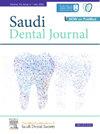Topical fluoride varnish application shifts dysbiotic dental plaque microbiome towards eubiosis in children with dental caries
IF 1.7
Q3 DENTISTRY, ORAL SURGERY & MEDICINE
引用次数: 0
Abstract
Objective
This study used high-throughput amplicon sequencing to examine the impact of long-term continuous fluoride treatment on the dental plaque microbiota of children aged 8 to 9 with mixed dentition.
Design
The study population consisted of twenty 8–9-year-old children with dental caries. Topical application of fluoride-varnish was weekly administered for one month to all subjects. Clinical indicators and anthropological data, such as the caries index (DMFT and dmft), were documented for every participant at baseline. A baseline assessment and a month after the fluoride varnish treatment were conducted for the salivary pH level and the Patient-Hygiene-Performance (PHP) index. Following application of the fluoride varnish, plaque samples were obtained both one month later and before (baseline) and were then used for 16S rRNA gene-based Next Generation Sequencing.
Results
The results showed significant differences in the community composition structure (p < 0.01). Notable caries-associated pathogens in the dental plaque microbiome were depleted whilst health associated phylum Proteobacteria was increased in the abundance following fluoride-varnish application. In children with mixed dentition, this study found that after one month of fluoride-varnish treatment, there was a significant decrease in the prevalence of the dominant pathogenic genera, Fusobacterium, Porphyromonas, Capnocytophaga, Neisseria, and Leptrotrichia, along with an increase in certain genera related to healthy oral condition, mostly from the phylum Proteobacteria, such as Areinmonas, Pseudoxanthomonas, and Luteimonas.
Conclusions
Fluoride-varnish application may shift the community level microecology from dysbiosis to eubiosis. Moreover, application of fluoride-varnish with weekly intervals for one month reduced the caries-causing bacteria while enriching the rise of unique, ubiquitous genera primarily belonging to the Proteobacteria, which may plaque a defensive role against progression of caries. Furthermore, a rising pH level towards neutrality (pH 7) indicated a healthier oral environment following the application of fluoride varnish.
龋齿儿童局部涂氟使菌群失调的牙菌斑微生物群向优生转变
目的本研究采用高通量扩增子测序技术,研究长期连续氟化物治疗对 8-9 岁混合牙儿童牙菌斑微生物群的影响。所有受试者每周局部涂抹氟化清漆,为期一个月。每位受试者的临床指标和人类学数据,如龋齿指数(DMFT 和 dmft),均在基线时记录在案。对唾液 pH 值和患者-卫生-表现(PHP)指数进行了基线评估,并在涂氟后一个月进行了评估。涂抹氟化物清漆后,在一个月后和一个月前(基线)采集牙菌斑样本,然后进行基于 16S rRNA 基因的新一代测序。使用氟化清漆后,牙菌斑微生物群中与龋病相关的病原体减少了,而与健康相关的变形菌门的数量增加了。本研究发现,在混合牙儿童中,经过一个月的氟化清漆治疗后,主要致病菌属--镰刀菌属、卟啉单胞菌属、嗜盖细胞菌属、奈瑟氏菌属和钩端螺旋体属--的数量显著减少,而与口腔健康状况相关的某些菌属则有所增加,这些菌属大多来自变形菌门,如阿赖诺单胞菌属、假黄单胞菌属和鲁特单胞菌属。结论涂抹氟化清漆可能会使群落微生态从菌群失调转变为优生。此外,在一个月内每周涂抹一次氟化清漆,在减少致龋菌的同时,增加了主要属于变形菌的独特、普遍的菌属,这些菌属可能对龋病的发展起着防御作用。此外,pH 值升至中性(pH 值为 7)表明涂抹氟化物清漆后口腔环境更加健康。
本文章由计算机程序翻译,如有差异,请以英文原文为准。
求助全文
约1分钟内获得全文
求助全文
来源期刊

Saudi Dental Journal
DENTISTRY, ORAL SURGERY & MEDICINE-
CiteScore
3.60
自引率
0.00%
发文量
86
审稿时长
22 weeks
期刊介绍:
Saudi Dental Journal is an English language, peer-reviewed scholarly publication in the area of dentistry. Saudi Dental Journal publishes original research and reviews on, but not limited to: • dental disease • clinical trials • dental equipment • new and experimental techniques • epidemiology and oral health • restorative dentistry • periodontology • endodontology • prosthodontics • paediatric dentistry • orthodontics and dental education Saudi Dental Journal is the official publication of the Saudi Dental Society and is published by King Saud University in collaboration with Elsevier and is edited by an international group of eminent researchers.
 求助内容:
求助内容: 应助结果提醒方式:
应助结果提醒方式:


